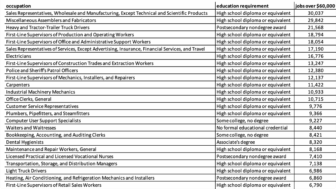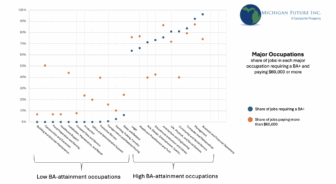A recent Washington Post article was entitled Half the jobs in America pay less than $18 an hour. Can ![]() Trump help? The consequence of way too many lower paid jobs––as well as too many working in part-time jobs––is you get lots of working American households who cannot afford to pay the bills, save for their retirement and their kids education.
Trump help? The consequence of way too many lower paid jobs––as well as too many working in part-time jobs––is you get lots of working American households who cannot afford to pay the bills, save for their retirement and their kids education.
This is occurring in an expanding economy with a low unemployment rate and corporate America doing quite well indeed. As we explore in our new report A Path to Good-paying Careers for all Michiganders: A 21st Century state policy agenda it is far past time for us to understand that a growing economy does not mean that most of us are enjoying a rising standard of living. That increasingly the two are decoupled. And if we are serious about an economy that works for all, we need to make rising household for all explicitly the goal of economic policy.
The United Way ALICE project is a terrific source for data on the consequences of the decoupling. ALICE is an acronym that stands for Asset Limited, Income Constrained, Employed. As we have explored previously Michigan is one of the states participating in the ALICE project.
The ALICE work defines the number of households with a working adult in a state that cannot pay for basic necessities: primarily housing, childcare, food, health care, taxes and transportation. Included in the calculation of household income are government transfer (safety net) payments and benefits. It also includes a cost of living calculation for each county of the states they have done a report on.
In Michigan 15% of households are below the federal poverty line. Another 25% qualify as an ALICE household. That means forty percent of Michigan households––in a strong economy with a very strong Detroit Three––cannot pay for basic necessities. And as the ALICE data make clear that is the case in every county, for every race and at all ages. This is an all Michigan problem.
In this post we look at data from the other ten states where ALICE data is available from either 2014 or 2015. Below are the percent of household in each of those states that is below the federal poverty line and those that are above that line but are ALICE households:
- Connecticut: 11%/27%
- Florida: 14.5%/29.5%
- Iowa: 12%/19%
- Indiana: 14%/22%
- Louisiana: 19%/23%
- Maryland: 10%/25%
- New Jersey: 11%/26%
- New York: 15%/29%
- Virginia: 11%/28%
- Wisconsin: 13%/29%
What stands out in the data above is the consistency of the results across what is a very diverse set of states. The proportion of households below the federal poverty line ranges from 10-15 percent in all states except Louisiana at 19%. And the ALICE household rate ranges from 22-29 percent except for Iowa at 19%.
Quite noteworthy is that high per capita income states––Connecticut, Maryland, New Jersey, New York and Virginia––all have ALICE rates at least as high as Michigan which is 32nd in per capita income.
Much of the reaction I get to data like this is race based. Some version of the places not doing well have a smaller proportion of whites. So I looked at the data for the nine states (including Michigan) that have data broken down statewide by race. The proportion of white households who are ALICE households ranges from 22-26 percent in each except for Iowa at 19% and Wisconsin at 29%. This is an all race problem. End of story.
So this is a national problem, not something unique to Michigan or to low-prosperity states like Michigan. The American economy structurally is not generating enough high-wage, full-time work so that everyone who works hard and plays by the rules can earn a middle class income.
As the United Way writes about ALICE, they:
… represents the growing number of individuals and families who are working, but are unable to afford the basic necessities of housing, food, child care, health care, and transportation. … ALICE workers are essential to the fabric of our society. ALICE works in jobs that are integral to our communities, from child care educators and home health aides to mechanics – all workers we rely on every day. The future success of our communities is directly tied to the financial stability of ALICE households. When ALICE suffers and is forced to make difficult choices, we all face serious consequences.
As we proposed in our Path to Good-Paying Careers for All Michiganders report we need to modify President Reagan’s framing of a job is the best social program to a good-paying job is the best social program. This is the great economic challenge of our times: having an economy that provides pay and benefits so that all who work can afford at least to pay for basic household necessities.







